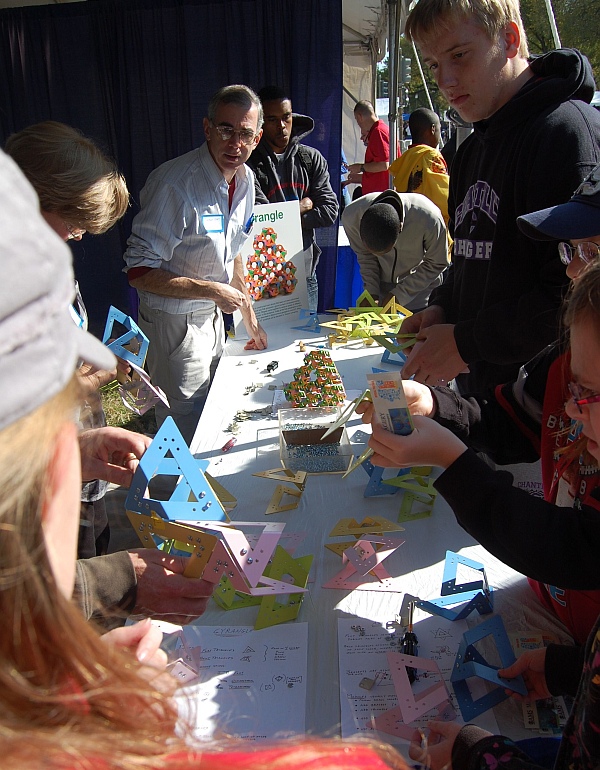This page reports on the assembly of this sculpture, which I call Gyrangle. Details of the design process and underlying mathematical foundations are described separately here. Above, you can see me sitting in front of it at its permanent home at Towson University, but most of the assembly was done in Washington D.C.
The assembly event took place on the
National Mall in Washington DC, in front of the Smithsonian Museum, as
part of the USA
Science and Engineering Festival. I was at the booth of the American
Mathematical
Society, which commissioned the sculpture.
Over three days, hundreds of people each contributed to the overall assembly.
We started with small units, pairs of
bent triangles joined with a connector.
These were simple enough that anyone who
could use a screwdriver could assemble them.
Some participants were young enough that we spent a lot of time explaining how to use a screw driver.
So the assembly went slower than I
originally anticipated, but still we all had lots of fun.

The weather was beautiful and thousands
of people attended the festival, so we were quickly swamped with
visitors. You can see me here trying to coordinate many different
activities at once.
Along the way, we explained how math
is used not just in science, engineering, economics, etc., but also in
design and art.
The two-triangle units are assembled into various eight-triangle units.
There are different color combinations and geometric variations to keep track of.
Soon we had built lots of the modules, each labeled to mark its position in the final structure.
The modules are then joined together into larger chunks of the sculpture.
We keep adding modules, being careful to ensure that parallel faces are the same color.
At the end of the second day of the festival, it was only two thirds finished.
We brought everything to Towson University and with the help of students and faculty finished it on the following day.
The 490 triangles each have twelve screws, so there are 5880 nuts and bolts!
I'm very happy with the result. Go to Towson's math department and see it in person.
For pictures of the completed Gyrangle sculpture, see this page.
For mathematical background about the design, see this page.
Read a nice article by Reza Sarhangi on the AMS web site.
And be sure to see the assembly video that Annette made.
And thank you Jim Paulson for making the excellent base.
You can look at a set of official event photos here.